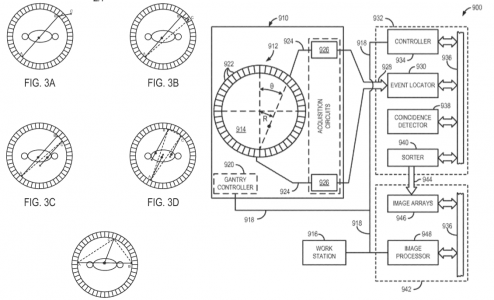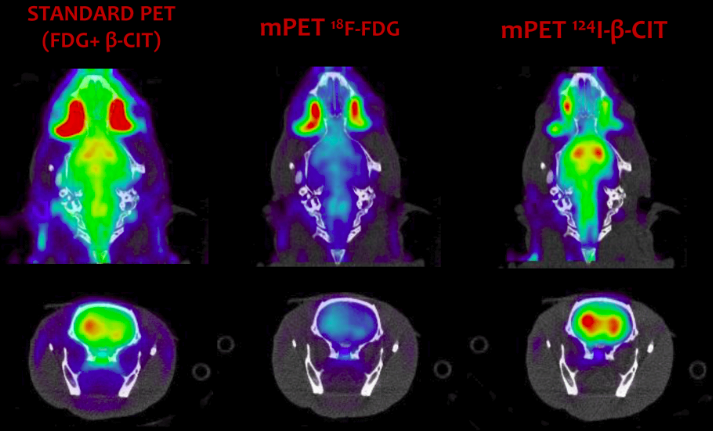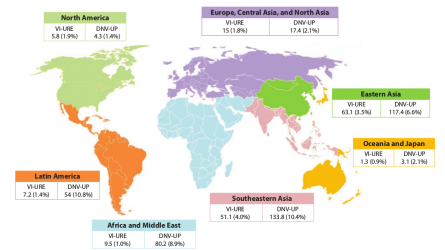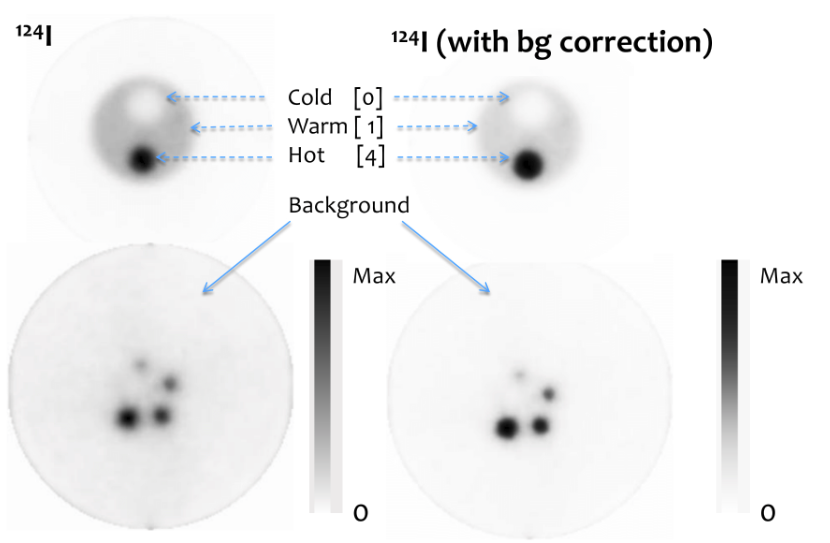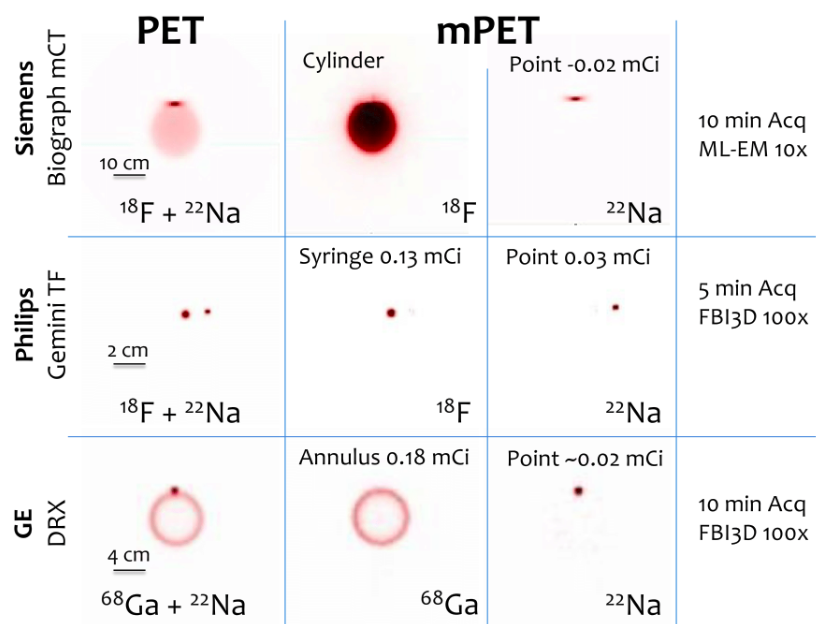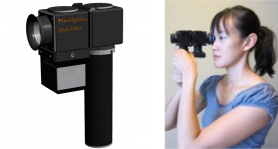| AUTHORS | ||
| APPLICATION NUMBER |
|
|
| PUBLICATION DATE | December 31st, 2014 | |
| ABSTRACT | A method and system for acquiring a series of medical images includes acquiring imaging data, identifying double coincidence events and multiple detection (MD) coincidence events from the imaging data, and storing the double coincidence events and the MD coincidence events in a first dataset and a second dataset, respectively. The method also includes applying a normalization correction to the first dataset and/or the second dataset using normalization values based on double coincidence events and/or MD coincidence events to obtain at least one normalized dataset, and reconstructing a series of medical images of the subject from the at least one normalized dataset. | |
| LINK | https://patentscope.wipo.int |
Year: 2014
| AUTHORS |
V. Parot
J. L. Herraiz
S. R. Dave
J. M. Udias
S. C. Moore
M.A. Park
J. J. Vaquero
E. Lage
|
| JOURNAL | IEEE Nuclear Science Symposium & Medical Imaging Conference, 2014 |
| ABSTRACT | Simultaneous noninvasive evaluation of biological processes can improve molecular imaging by providing complementary tissue functions under equivalent conditions coregistered in space and time. Positron Emission Tomography (PET) is the most sensitive noninvasive molecular imaging tool, able to measure many physiological properties with a number of radiotracers. Unfortunately, positron annihilation gamma rays are identical for all radiotracers, making them indistinguishable with standard PET imaging. This fact has motivated attempts at dual tracer imaging with standard PET to distinguish radiotracers using timebased differences. |
| AUTHORS |
J. F. P. J. Abascal
E. Lage
M. E. Martino
J. L. Herraiz
M. Desco
J. J. Vaquero
|
| JOURNAL | IEEE Nuclear Science Symposium & Medical Imaging Conference, 2014 |
| ABSTRACT | Dynamic PET images suffer from low signaltonoise ratio (SNR), especially for fast contrast uptake measurements due to the small number of counts available in those time frames. In this work, we propose a 4D reconstruction method based on spatiotemporal total variation (STTV) which takes advantage of image redundancies in 4D. The 4D STTV method was efficiently implemented using the Split Bregman formulation, which has been shown to be optimal for decreasing noise while maintaining image quality. To evaluate the proposed approach we acquired listmode data from a NEMA image quality phantom in a preclinical PET/CT scanner. |
| AUTHORS |
Nicholas J. Durr
Shivang R. Dave
Eduardo Lage
Susana Marcos
Frank Thorn
Daryl Lim
|
| JOURNAL | Annual Review of Biomedical Engineering, Vol 16, July 2014 |
| ABSTRACT | Worldwide, more than one billion people suffer from poor vision because they do not have the eyeglasses they need. Their uncorrected refractive errors are a major cause of global disability and drastically reduce productivity, educational opportunities, and overall quality of life. The problem persists most prevalently in low-resource settings, even though prescription eyeglasses serve as a simple, effective, and largely affordable solution. In this review, we discuss barriers to obtaining, and approaches for providing, refractive eye care. We also highlight emerging technologies that are being developed to increase the accessibility of eye care. Finally, we describe opportunities that exist for engineers to develop new solutions to positively impact the diagnosis and treatment of correctable refractive errors in low-resource settings. |
| LINK | https://www.annualreviews.org/ |
| AUTHORS |
Eduardo Lage
Joaquin Herraiz
Vicente Parot
Shivang Dave
|
| APPLICATION NUMBER | PCT/US2013/068858 |
| PUBLICATION DATE | May 15th, 2014 |
| ABSTRACT | A method and system for acquiring a series of medical images includes receiving medical imaging data corresponding to photons emitted from a subject having received a dose of a radiotracer. Determining, from the medical imaging data, coincidence events including photon coincidence events involving two photons and photon coincidence events involving more than two photons. The photon coincidence events involving two photons and photon coincidence events involving more than two photons are processed and use to reconstruct a series of medical images of the subject. |
| LINK | https://patentscope.wipo.int |
| AUTHORS |
J Cal-González
E Lage
E Herranz
E Vicente
J M Udias
S C Moore
M-A Park
S R Dave
V Parot
J L Herraiz
|
| JOURNAL | Physics in Medicine & Biology, Vol 60, No 1, December 2014 |
| ABSTRACT | Although current PET scanners are designed and optimized to detect double coincidence events, there is a significant amount of triple coincidences in any PET acquisition. Triple coincidences may arise from causes such as: interdetector scatter (IDS), random triple interactions (R T ), or the detection of prompt gamma rays in coincidence with annihilation photons when non-pure positron-emitting radionuclides are used (β + γ events). Depending on the data acquisition settings of the PET scanner, these triple events are discarded or processed as a set of double coincidences if the energy of the three detected events is within the scanner’s energy window. This latter option introduces noise in the data, as at most, only one of the possible lines-of-response defined by triple interactions corresponds to the line along which the decay occurred. |
| AUTHORS |
J. L. Herraiz
S. C. Moore
V. Parot
S. R. Dave
M.A. Park
S.S. Yoo
W. Lee
H. Kim
E. Lage
|
| JOURNAL | IEEE Nuclear Science Symposium & Medical Imaging Conference, 2014 |
| ABSTRACT | Nonstandard PET radionuclides like 124 I, 76 Br, or 86 Y, emit prompt gamma rays together with the positrons which can be detected in coincidence with annihilation photons, creating spurious double coincidences. This causes a background in the PET images that reduces contrast and hampers quantitative accuracy. Existing correction methods are computationally intensive and since they depend on the size of the subject and on the accuracy of a number of complicated estimates, they may be valid for large source distributions only up to a certain size. To overcome these challenges, we have implemented a novel correction which is based on the measurement of positron+gamma triple coincidences. |
| AUTHORS |
J. L. Herraiz
S. C. Moore
M. Cervo
S. España
J. Ruiz-Cabello
E. Lage
|
| JOURNAL | IEEE Nuclear Science Symposium & Medical Imaging Conference, 2014 |
| ABSTRACT | Simultaneous invivo imaging of the biodistribution of two or more radiotracers of interest with Positron Emission Tomography (PET) could provide more comprehensive information about specific targets and physiological processes of interest; however, conventional PET cannot separate different positronemitting radionuclides based on the energy of the detected gamma photons. We have shown previously that the detection of triplecoincidence events allows the separation of radiotracers labeled with positron + gamma emitters (like 124 I) from others labeled with standard pure positron emitters (like 18 F), without requiring any kinetic modelling or precise energy measurement. The goal of the current study was to demonstrate that this methodology can also be applied to clinical PET scanners. |
| AUTHORS |
J. López Herranz
F. Mulero Aniorte
V. Parot
S. Dave
S. Moore
J.M. Udias
J.J. Vaquero
E. Lage
|
| JOURNAL | Revista Española de Medicina Nuclear e Imagen Molecular, Vol. 33, Supl. 1, 2014 |
| ABSTRACT | Objetivo: La PET es la modalidad de imagen con mejores prestaciones para la obtención de información funcional y molecular in vivo. Sin embargo, esta técnica no permite la utilización de más de un radiotrazador de forma simultánea debido a que las señales emitidas por los radionúclidos utilizados para el marcaje son indistinguibles entre sí. En este trabajo se introduce una nueva metodología (mPET) que permite la adquisición y separación de las imágenes de al menos dos trazadores en escáneres PET convencionales. |
| AUTHORS |
Eduardo Lage
Fuensanta Ascension Vera-Diaz
Shivang R Dave
Daryl Lim
Carlos Dorronsoro
Susana Marcos
Frank Thorn
Nicholas J Durr
|
| JOURNAL | Investigative Ophthalmology & Visual Science, Vol.55, Issue 13, April 2014 |
| ABSTRACT | Purpose: To evaluate the performance of a low-cost wavefront aberrometer in measuring refractive errors. |



